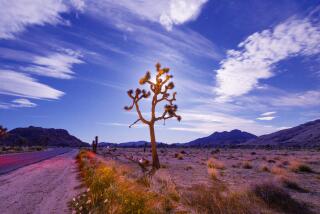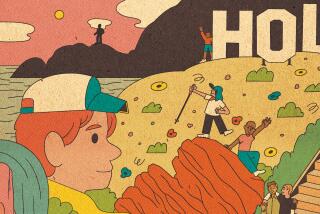Out with the after-hours crowd
Scott Scott doesn’t believe darkness should get in the way of a good hike. “I think a moonrise is just as spectacular as a sunrise,” says the Palm Springs guide, who starts hiking at dusk at this time of year.
Unless you live in the northern latitudes where folks enjoy extra-late sunsets, it’s lights out by 7 p.m. in Southern California. But shorter days don’t have to mean shorter time outdoors.
On full moon nights, you can ride, hike, surf or kayak -- often without a flashlight. Nighttime adventures are quieter and cooler, and wildlife is active.
Hiking at night “changes your perspective,” says Scott, chief guide and co-owner of Desert Safari/Trail Discovery Guide Service. You may not be able to see as much, but that’s not necessarily a bad thing, says Scott. The darkness allows you to focus and “concentrate more on the experience.”
“Your senses are heightened because you’re not relying on sight as much,” says Scott, who leads monthly full moon hikes in the foothills of the San Jacinto Mountains when triple-digit summer temperatures plummet. Nighttime coolness also increases the chances of seeing nocturnal creatures such as kangaroo rats, bats and occasionally nighthawks.
Big moons offer interesting eye candy, like moonshadows playing light tricks on canyon walls or the shimmer of light on a serene ocean bay.
For nighttime outings, there’s usually plenty of light two nights before and two nights after a full moon -- provided skies are clear, says Tony Cook, astronomical observer at the Griffith Observatory in Griffith Park.
To make the most of a full moon, pinpoint the hours of sunrise and sunset as well as moonrise and moonset. On the Naval Observatory website aa.usno.navy.mil/data/docs/RSOneYear.html, you can plug in the name of a city and retrieve a year’s worth of orbital data.
Moonrises make for dramatic photographs, says Jim Belsley, an amateur shooter who recently led a full moon Meet and Shoot hike at Castro Crest in the Santa Monica Mountains.
When it comes to shooting a moon -- the photographic kind -- Belsley gives himself a time frame of about an hour.
Using a tripod, he starts shooting about 30 minutes before sunset and continues until 30 minutes after.
“You get that sky getting darker, which is bringing out the moon, while still getting enough light for interesting trees or rocks in the foreground,” he says.
Humans aren’t the only creatures stirred by moonlight. Birds and sea lions on Mission Bay are most active at dusk, says Charlton DuRant, manager of Aqua Adventures in San Diego, who leads after-hours kayak trips. You’ll see a “dramatic change in human wildlife behavior,” he says, as boat traffic and noise levels diminish.
A light show of a different type can be seen at night from a kayak, says DuRant, in the form of bioluminescence, which occurs when certain ocean organisms produce light. A worm called Odontosyllis produces a green glow during mating rituals every two weeks between July and October in Mission Bay during the first and last quarters of the moon, says Michael Latz of the Scripps Institution of Oceanography in La Jolla.
Paddlers who venture toward SeaWorld, says DuRant, can check out penguins in their bayside enclosure and sometimes catch a fireworks display at the park.
If you want to hit the trail or the waves at night, be aware of some of the challenges.
Of course, it’ll be dark, meaning it’s tougher to see and a bit easier to get lost. Evening adventurers should always carry a flashlight in their packs. And nighttime trekkers should bring plenty of water, especially in the desert.
Mountain bikers should bring “anything you’d bring for a daytime ride, plus lights,” says Paul Marusich, an interpretive ranger at McDowell Mountain Regional Park in Fountain Hills, Ariz., west of Phoenix. Maricopa County sponsors a moonlight mountain bike ride on the park’s 15-mile Pemberton Trail, leaving just after sunset on full moon nights.
Marusich recommends a handlebar light that enables you to see where the tires are going and a helmet light or headlamp to see what’s ahead. One key to riding at night is to stick to trails you’re familiar with, and slow down. “It’s a different trail [at night],” he says. “Even if you’ve ridden that trail a thousand times in daylight, [it’s like] you’ll be riding it for the first time at night.”
*
(BEGIN TEXT OF INFOBOX)
Try these nightspots
Take full advantage of the full moon on hikes and paddles.
Desert Safari/Trail Discovery Outdoor Guide Service: Full moon hikes most months, (888) TO- SAFARI.
Santa Monica Mountains: Nearly full moon hike, Franklin Canyon Ranch, Sept. 27, 6:30 p.m., (310) 858-7272, Ext. 131.
Charmlee Wilderness Park: Full moon hike, Sept. 28, 6:30 p.m., reservation required, (310) 317-1364.
Coldwater Canyon Park: Full moon hike, Sept. 28, 7:30 p.m., call TreePeople for a reservation, (818) 623-4866.
Aqua Adventures’ Kayak by the Full Moon: Sunday, 6 to 8 p.m., $35 per person includes kayak rental, $20 with own kayak, (619) 523-9577.
Blue Waters Kayaking: Tomales Bay (Point Reyes National Seashore, Marin County); full moon paddle, Sept. 28, 7 to 10 p.m., $65, (415) 663-1743.
*
Upcoming full moons
Sept. 28
Oct. 28
Nov. 26
Dec. 26
*
To e-mail Julie Sheer or read her previous Outdoors Institute columns, go to latimes.com/juliesheer.
More to Read
Sign up for The Wild
We’ll help you find the best places to hike, bike and run, as well as the perfect silent spots for meditation and yoga.
You may occasionally receive promotional content from the Los Angeles Times.






